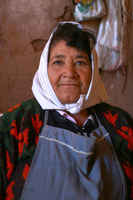Taco Pampa, Argentina: a threatened model of social economy
For over 100 years, a group of approximately 80 families have been living and maintaining a productive system in the territory of the department of La Paz which has enabled not only the survival of these families, but a model of production that is balanced with the environment.
In June 2004, the bulldozers of the national and US capital enterprise Los Poquiteros S.A intended to enter the fields belonging to these families, and the population started the resistance.
In the 52,000 has. which comprise the localities of El Quimilo, Palo Santo, El Chaguaral, El Clérigo, San Isidro, San Vicente, San Agustín, and Pozo Verde, 1600 bovines, 4200 goats, and around 400 horses have grazed and drank without knowing any fences or enclosures, passing through large extensions in order to get food and water, in an arid and salty ground.
This landscape, one of the last ones with native virgin scrubland, has been preserved almost with no changes thanks to this production system, the inhabitant takes only what is necessary to survive.
During the last years, the PSA has provided technical support in the organizational aspects as well as the cleanup and improvement of the livestock, material resources for the construction of dams and corral, low scale forage cultivation, etc.
As of December 2003, this production system, that has enabled the survival of the families and the development of the small communities, has been threatened by the sale of the ranch Taco Pampa to a national and American capital enterprise. These 116,000 has. that have been sold are comprised in the 52 thousand belonging to these families, who given the lack of documents certifying their possession for over 100 years, have been forced to claim before justice and provincial and legislative organisms, respect for their way of living, growing, and developing their community for over more than 7 generations.
In this process, they have acquired the support of, among others, the vice gobernaci ó n , who has provided the economic means to have specialized legal assistance.
They have also summoned environment defense organisms, universities and programs which are now dedicated to establishing by consensus with the population, lines of action that will allow them to continue with the production and life system that they have been developing and that is considered the most adequate for the preservation of the ecosystem.
The union of the producers for the defense of their land constitutes in itself a developing process of the community itself, which has incremented its visibility, has enabled the genetic improvement of the livestock, the improvement of its health, the establishment of a supportive system of collaboration among producers, the formalization of a producer association which enables the associated resource management, the participation in training forums, etc.
One of the villages located in this area of land at stake in the department of La Paz, is the community of Palo Santo, which is located 12 km south of El Quimilo, the biggest town where the municipal office, school, public registry office, health clinic, and church can be found.
Palo Santo is the locality located deepest into the salt desert and its production model is the same one that applies in all the other villages of the former Taco Pampa ranch.
Juan Abregú, a producer from Palo Santo, talks about his first-hand experience:
We are 7 families living in Palo Santo, 20 people raise the goats; we raise goats, cows and mares.
The earth is not meant for crops, because of the lack of water and the salty ground.
We get honeycomb and we hunt for consumption.
We all work: the women go to the goat corral and do the housework. They also get water from the wells.
The men give water to the cows, we watch them while they graze, we search for wood, we build the houses.
The children help in the corral; they give water to the goats. We all work.
We work from the break of day until noon, we eat, and we continue giving water, especially in this late winter time, because there is no water in the dams.
Many young people have left to study, so we need help.
When the water from the dams is out, and it is here that we collect rain water, then we take water from the wells, which we have to dig because they fill up with mud.
There are 350 cows, 1200 goats, 100 mares; besides, we have pigs, hens.
We have 200 calves a year, and at least 1200 kids, which we sell so we can live because we don’t have a salary.
We sell the males, and the females we keep them to produce youngs.
We spend on the bovines, the “Guides to sell”, remedies, and corn for the animals. The money from the sell is used so we can eat, cure, dress and travel.
Sometimes we have some money left that we can save for an emergency.
We also save when we hunt, with the wood that we get from the field and the construction material for corrals, houses, enclosures for grass. We collect fruit from the field: cardón, carob bean, and mistol.
We sell the calves at $400, the kids at $45, and the mares at $400.
That’s $80,000 in calves, $54,000 in kids, and $8,000 in horses: a total of $142,000, around $20,000 per family per year.
We use this money to pay the bill where we buy the groceries and for the family.
To be able to produce we use our field, which has 16,300 has., because one cow needs at least 15 has. to be able to eat, a goat needs 3 has., and a horse needs 20 has.
The field has grass in some parts and it’s salty in others, where there’s less.
The animals eat in different zones according to the time of the year and they drink close to the houses, in the dams. We use enclosures to keep the grass.
It has been done in this manner since our parents started it, and it has been preserved because we have taken good care of it.
We want to keep doing it in this way because this is what we live from, let alone the enterprise wanting to take it from us.
“The enterprise” is Los Poquiteros S.A., of national and US capital, which on December 12th, 2003, in a Notary’s office, acquired the control of 116,400 has. of the area of the department of La Paz at $407,050 dollars. From the territorial point of view, the acquisition comprises 36% of the department of La Paz, which is the fourth largest department in the province of Catamarca.
In June 2004, the bulldozers tried to enter the fields (and in some cases, the corrals) belonging to these families who inhabit 52,000 has. for 150 years, and the population started the resistance and the actions to acknowledge their rights over the land.
Since then, they have been proposing before the justice with specialized legal representation provided by the vice government, the acknowledgement of the legitimacy of their rights as landholders (holders as owners).
In this judicial road, it has been achieved that the localities of El Clérigo, Pozo Verde, El Chaguaral be under no-innovation measures.
It has been possible to wire 65% of the perimeter bordering the enterprise and to delimit with other elements (branch enclosures and sticks) the 85% of all the limits.
It was also achieved that regardless of the intimidating actions of the enterprise, it hasn’t been able to move forward over the land marked by the neighbors.
This year, the inhabitants have advanced on a road of acknowledgement and discovery. Acknowledgement and exercising of rights.
Discovery of individual and collective capacities which have been put to serve the cause. They have transcended the individual and their own community to unite with the neighbors from other villages and to plan out together not only defense strategies, but also joint production, now that wire has become, for the first time in generations, part of their productive system.
They have formed an association (which they have named “Los Ganaderos” [“The Farmers”] as a reflection of their collective identity) which unites them as producers and owners of the land by means of which they manage the necessary resources to defend and produce.
Based on technical grounds, they maintain that their productive system is the only one that preserves the environment and, on these grounds, their efforts have been joined by the University of Cordoba, the INTA, National Parks, the Secretaría de Tierras y Hábitat Social de la Nación (National Land and Social Habitat Subsecretary), and a large part of the public opinion, which is coming to know the problem.
The productive project of Los Poquiteros suggests a farming development with the same amount of livestock as the 80 families.
But the treatment that the land has received during these 3 years is far from being like the one that the farmers have given it for 150 years.
In January 2007 the organism who is responsible of the province’s environment, authorized the enterprise to clear 600 has. of native woods, which adds to what has already been done in terms of perforation and roads, etc.
The 52,000 has. inhabited by these families constitute their means of living and developing of their communities.
All the knowledge of the inhabitants is linked to the land.
If this land is taken away from them, they will be automatically excluded from the productive system and they will become part of the unemployment list and of people who depends on the State to live.


